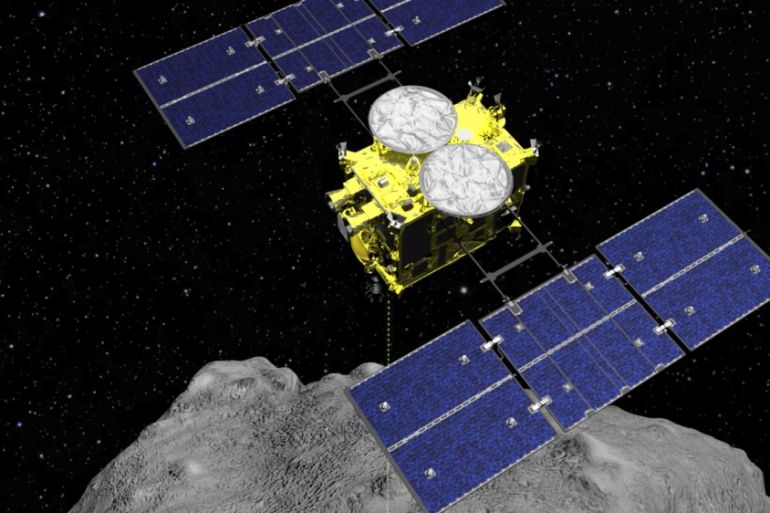Touchdown: Japan’s Hayabusa2 makes final landing on asteroid
The spacecraft collected data which scientists hope could provide clues to the origin of the solar system.

A Japanese spacecraft has landed on a distant asteroid and collected underground samples that scientists hope will provide clues to the origin of the solar system billions of years ago.
Japan‘s space agency said on Thursday that the Hayabusa2 spacecraft landed inside a crater it had created on the Ryugu asteroid months earlier and collected samples that scientists believe contain valuable data unaffected by space radiation and other environmental factors.
Keep reading
list of 4 itemsBoeing postpones launch of Starliner space capsule after technical fault
China launches Chang’e-6 probe to study dark side of the moon
China launches historic mission to far side of the moon
Hayabusa2 is the first spacecraft to successfully collect underground samples from an asteroid. A similar mission is planned by NASA on another asteroid, Bennu.
The Japan Aerospace Exploration Agency, or JAXA, said the data shows Hayabusa2 touched down and rose safely after collecting the samples.
|
|
Research director Takashi Kubota told reporters that the touchdown operation was “more than perfect”, adding that project manager Yuichi Tsuda told the team: “We have made history”.
Thursday’s brief landing is the second time Hayabusa2 has touched down on the desolate asteroid Ryugu, which lies some 300 million kilometres from Earth.
The complex multi-year mission has also involved sending rover and robots down to the surface.
The news was greeted with cheering and applause in the JAXA mission control room, with officials grinning and shaking hands.
JAXA officials said earlier that the probe appeared to have landed successfully, but confirmation came only after Hayabusa2 lifted back up from the asteroid and resumed communications with the control room.
“I hope Hayabusa2 will return to Earth safely after successfully extracting samples from the asteroid, which would be a first,” Kotaro Nogami, Japanese deputy government spokesperson said.
‘Extremely attractive’ materials
The touchdown was intended to collect pristine materials from beneath the surface of the asteroid that could provide insights into what the solar system was like at its birth, some 4.6 billion years ago.
To get at those crucial materials, in April an “impactor” was fired from Hayabusa2 towards Ryugu in a risky process that created a crater on the asteroid’s surface and stirred up material that had not previously been exposed to the atmosphere.
The second touchdown required special preparations because any problems could mean the probe would lose the precious materials already gathered during its first landing.

A photo of the crater taken by Hayabusa2’s camera after the April blast showed that parts of the asteroid’s surface are covered with materials that are “obviously different” from the rest of the surface, mission manager Makoto Yoshikawa told reporters before the latest touchdown.
“It would be safe to say that extremely attractive materials are near the crater,” Project Manager Yuichi Tsuda said.
The touchdown is the last major part of Hayabusa2’s mission, and when the probe returns to Earth next year, scientists hope to learn more about the history of the solar system and even the origin of life from its samples.
“I’m really looking forward to analysing these materials,” Yoshikawa said.
At about the size of a large refrigerator and equipped with solar panels to keep it powered, Hayabusa2 is the successor to JAXA’s first asteroid explorer, Hayabusa – Japanese for falcon.
The Hayabusa2 mission was launched in December 2014 and has a price tag of around 30 billion yen ($270m).